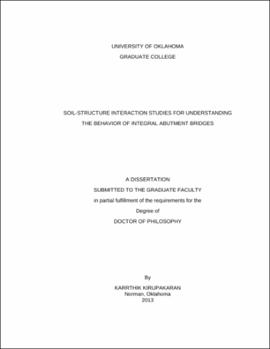| dc.contributor.advisor | Muraleetharan, Kanthasamy K. | |
| dc.creator | Kirupakaran, Karrthik | |
| dc.date.accessioned | 2019-04-27T21:27:39Z | |
| dc.date.available | 2019-04-27T21:27:39Z | |
| dc.date.issued | 2013 | |
| dc.identifier | 99207569702042 | |
| dc.identifier.uri | https://hdl.handle.net/11244/318737 | |
| dc.description.abstract | Integral Abutment Bridges (IABs) are increasingly being used to eliminate undesirable effects of bridge joints on the long-term performance of bridges. Behavior of abutments in IABs is, however, poorly understood. Soil-structure interactions at the abutments occurring during thermal loading of a bridge are complex, especially in skewed and long span IABs. This research describes an effort to understand the complex soil-structure interactions occurring in IABs and to propose design guidelines. | |
| dc.description.abstract | The North-bound I-44 Bridge over Medicine Bluff Creek in Comanche County near Lawton, Oklahoma, a 210 feet long, three span IAB with a 10o skew was instrumented for the study and more than three years of data were collected. Instrumentation included pile strain gages, earth pressure cells, tiltmeters, crackmeters, and thermistors. The temperature variation across the depth of superstructure was not uniform and a thermal gradient existed. The field measured seasonal bridge temperatures agreed with the temperature range specified in AASHTO LRFD Specifications. Fairly significant abutment back pressures occurred during the summer and the majority of bridge translation was accommodated by the abutment pile movements in IABs. Abutment piles of IABs were experiencing bending moments beyond the yield bending moment at shallow depths. | |
| dc.description.abstract | Behavior of the Oklahoma IAB was studied using computer programs LPILE, GROUP and TeraDysac. Computed bending moments for abutment piles confirm that piles have yielded at shallow depths. Three-dimensional model developed in GROUP shows biaxial bending of abutment piles occurs due to the skew of the bridge. Field measured bending moments for the south abutment pile have lower values than the computed bending moments; very likely due to the installation of these piles in pre-drilled holes and not considering the thermal gradient in modeling. Computed TeraDysac bending moments have better agreement with field measurements. A parametric study was conducted to propose design guidelines for IABs. According to this study, in order to accommodate thermal movement in IABs and to reduce bending moments in abutment piles, a smaller HP pile section should be placed in weak axis bending and in pre-drilled holes with low stiffness fill material, especially at shallow depths. Abutment piles for IABs should be checked for capacities under combined axial force and bending moments. Bridges built with longer spans and larger girders will increase the axial load on the abutment piles and concrete stresses in the superstructure, and therefore long-span IABs should be designed with caution. Inclusion of a compressible material and using a flowable fill (CLSM) or using a backfill with soil reinforcement will reduce the passive pressures and settlement of soil behind the abutments. For IABs with larger skew angles, abutment piles should be oriented in weak axis bending along transverse direction. Biaxial bending of abutment piles in skewed IABs increases stresses in the concrete superstructure and the structural components for IABs with larger skew angles have to be designed with caution to accommodate the thermally induced deformations and avoid distresses within the superstructure. | |
| dc.format.extent | 208 pages | |
| dc.format.medium | application.pdf | |
| dc.language | en_US | |
| dc.relation.requires | Adobe Acrobat Reader | |
| dc.subject | Soil-structure interaction | |
| dc.subject | Bridges--Design and construction | |
| dc.subject | Soils--Analysis | |
| dc.subject | Bridges--Abutments | |
| dc.title | Soil-Structure Interaction Studies for Understanding the Behavior of Integral Abutment Bridges | |
| dc.type | text | |
| dc.type | document | |
| dc.thesis.degree | Ph.D. | |
| ou.group | College of Engineering::School of Civil Engineering and Environmental Science | |
